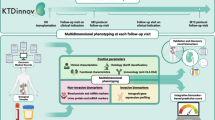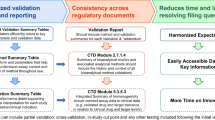Abstract
Purpose
The purpose of this study was to evaluate the suitability of whole blood microsampling procedures in non-human primate (NHP) to support toxicokinetic assessments of biotherapeutics in non-human primates.
Method
A one-month single dose intravenous pharmacokinetic (PK) study was performed in male cynomolgus monkeys with a human IgG1 control monoclonal antibody (mAb) as a surrogate monoclonal antibody biotherapeutic. In this study, both serum samples (conventional sample collection) and microsampling samples were collected. Microsampling samples were collected from two sites on cynomolgus monkey, with each site using two different devices for the whole blood collection. The drug concentrations from all sample types were determined using a quantitative ligand binding assay (LBA). The PK parameters obtained from microsampling samples and serum samples were examined using a standard PK analysis method. The comparability of key PK parameters from both sample types were analyzed statistically.
Results
Similar profiles of drug concentrations versus timepoints from all sampling procedures were observed. The correlations of PK concentration data obtained from serum and microsampling samples were ≥ 0.97 using Brand Alman Plot analysis. The key PK parameters obtained from microsampling samples were comparable to those obtained from serum samples (the % differences of mean PK parameters obtained from both sample types were within ±25%).
Conclusion
This study confirmed that PK parameters obtained from samples using microsampling were comparable to that of serum samples in cynomolgus monkeys. Therefore, the microsampling procedure described can be used as a substitute for conventional sampling procedure to support PK/TK studies of biotherapeutics in non-clinical product developments.







Similar content being viewed by others
Abbreviations
- AUC:
-
Area Under the Concentration-Time Curve
- CL:
-
Clearance
- Cmax:
-
Maximum Drug Concentration
- CMS:
-
Capillary Microsampling
- DBS:
-
Dried Blood Spot
- DQC:
-
Dilution Quality Control
- GLP:
-
Good Laboratory Practices
- HQC:
-
High Quality Control
- IND:
-
Investigational New Drug
- LBA:
-
Ligand Binding Assay
- LC-MS:
-
Liquid Chromatography-Mass Spectrometry
- LIMS:
-
Laboratory Information Management System
- LLOQ:
-
Lower Limit of Quantitation
- LMS:
-
Liquid Microsampling
- LQC:
-
Low Quality Control
- LTS:
-
Long-Term Stability
- mAb:
-
Monoclonal Antibody
- MQC:
-
Middle Level Quality Control
- MRD:
-
Minimum Required Dilution
- MSD:
-
Mesoscale Discovery
- PD:
-
Pharmacodynamic
- PK:
-
Pharmacokinetic
- POCT:
-
Point of Care Test
- QC:
-
Quality Control
- RE:
-
Relative Error
- RPM:
-
Revolutions Per Minute
- RT:
-
Room Temperature
- T 1/2:
-
Half-life
- TK:
-
Toxicokinetic
- ULOQ:
-
Upper Limit of Quantitation
References
Abu-Rabie P, Spooner N. Direct quantitative bioanalysis of drugs in dried blood spot samples using a thin-layer chromatography mass spectrometer interface. Anal Chem. 2009;81(24):10275–84.
Bowen CL, Licea-Perez H, Karlinsey MZ, Jurusik K, Pierre E, Siple J, et al. A novel approach to capillary plasma microsampling for quantitative bioanalysis. Bioanalysis. 2013;5(9):1131–5.
Joyce AP, Wang M, Lawrence-Henderson R, Filliettaz C, Leung SS, Xu X, et al. One mouse, one pharmacokinetic profile: quantitative whole blood serial sampling for biotherapeutics. Pharm Res. 2014;31(7):1823–33.
Nilsson LB, Ahnoff M, Jonsson O. Capillary microsampling in the regulatory environment: validation and use of bioanalytical capillary microsampling methods. Bioanalysis. 2013;5(6):731–8.
Chapman KL, Holzgrefe H, Black LE, Brown M, Chellman G, Copeman C, et al. Pharmaceutical toxicology: designing studies to reduce animal use, while maximizing human translation. Regul Toxicol Pharmacol. 2013;66(1):88–103.
Sparrow SS, Robinson S, Bolam S, Bruce C, Danks A, Everett D, et al. Opportunities to minimise animal use in pharmaceutical regulatory general toxicology: a cross-company review. Regul Toxicol Pharmacol. 2011;61(2):222–9.
Wagner M, Tonoli D, Varesio E, Hopfgartner G. The use of mass spectrometry to analyze dried blood spots. Mass Spectrom Rev. 2016;35(3):361–438.
Lei BUW, Prow TW. A review of microsampling techniques and their social impact. Biomed Microdevices. 2019;21(4):81.
Patel SR, Bryan P, Spooner N, Timmerman P, Wickremsinhe E. Microsampling for quantitative bioanalysis, an industry update: output from an AAPS/EBF survey. Bioanalysis. 2019;11(7):619–28.
Zhu L, Wang Y, Joyce A, Djura I, Gorovits B. Fit-for-purpose validation of a ligand binding assay for Toxicokinetic study using mouse serial sampling. Pharm Res. 2019;36(12):169.
Choi K, Chang J, Lee MJ, Wang S, In K, Galano-Tan WC, et al. Reference values of hematology, biochemistry, and blood type in cynomolgus monkeys from Cambodia origin. Lab Anim Res. 2016;32(1):46–55.
Caron, A. Lelong, C. Pascual, M. H. Benning, V (2015). Miniaturized blood sampling techniques to benefit reduction in mice and refinement in nonhuman primates: applications to bioanalysis in toxicity studies with antibody-drug conjugates. J Am Assoc Lab Anim Sci 2015;54(2):145–52. https://www.ncbi.nlm.nih.gov/pubmed/25836960.
FDA's Guidance for industry: Bioanalytical Method Validation Guidance for Industry, 2018.
FDA's Guidance for Industry: S3A Guidance: Note for Guidance on Toxicokinetics: The Assessment of Systemic Exposure in Toxicity Studies: Focus on Microsampling: Questions and Answers, 2018.
Author information
Authors and Affiliations
Corresponding author
Additional information
Publisher’s Note
Springer Nature remains neutral with regard to jurisdictional claims in published maps and institutional affiliations.
Co-author worked on manuscript while employed with Pfizer, Inc.
Rights and permissions
About this article
Cite this article
Wang, Y., Crowell, S.J., Joyce, A. et al. Application of blood microsampling in cynomolgus monkey and demonstration of equivalent monoclonal antibody PK parameters compared to conventional sampling. Pharm Res 38, 819–830 (2021). https://doi.org/10.1007/s11095-021-03044-6
Received:
Accepted:
Published:
Issue Date:
DOI: https://doi.org/10.1007/s11095-021-03044-6




